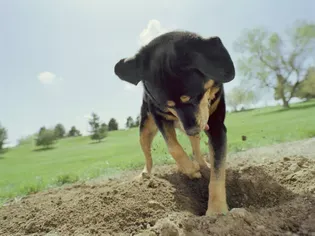Why Dogs Bury Bones and Other Objects
Updated on 05/26/24

Why Dogs Bury Bones and Other Objects: Digging into Their Instincts and Reasons
Introduction:
Dogs are fascinating creatures whose behaviors often intrigue us. One of their peculiar habits is burying bones and other objects. While it may seem like a strange behavior, it actually has deep-rooted instincts and practical reasons behind it. In this comprehensive blog post, we will delve into the reasons why dogs bury bones and other objects, exploring their natural instincts, survival mechanisms, and psychological motivations.
1. Instinctive Behavior:
Dogs are descended from wolves, which are territorial animals that cache food for future consumption. Burying bones and other objects is an instinctive behavior that has been passed down through generations. When a wolf makes a kill, it will typically bury the excess food to prevent other animals from stealing it. This behavior ensures that the wolf has a food source to return to later.
2. Resource Protection:
Dogs are protective of their resources, including food, toys, and bedding. Burying objects is a way for dogs to secure their possessions and prevent others from accessing them. By hiding their valuables underground, dogs can rest assured that their resources will be there when they need them. This behavior is particularly common in dogs that live in multi-pet households or have experienced resource competition in the past.
Example: A dog named Max loves to bury his favorite squeaky toy in the backyard. Whenever he finishes playing with it, he will carefully dig a hole and bury the toy, ensuring that it is safe and out of reach of his curious canine companion, Molly.
3. Future Planning:
Some dogs bury bones and other objects as a form of future planning. They may be anticipating a time when food is scarce or unavailable. By burying their resources, dogs are essentially creating a food storage system for themselves. This behavior is more common in dogs that have experienced periods of food insecurity or have witnessed other dogs burying food.
Example: Daisy, a rescued dog, has a habit of burying her treats in various spots around the house. Her previous owners speculate that she developed this behavior due to her uncertain food supply in her previous home. By burying her treats, Daisy ensures that she has a hidden stash to rely on if food becomes scarce again.
4. Boredom and Entertainment:
Burying objects can also be a form of entertainment for dogs. Digging is a natural behavior for dogs, and it can be a stimulating and enjoyable activity. By burying bones and other objects, dogs can exercise their digging instincts and satisfy their curiosity.
Example: Buddy, a playful Labrador, loves to bury his chew toys in the park. He will often spend hours digging holes and hiding his toys, only to dig them up again later and play with them. For Buddy, burying toys is a fun and engaging pastime.
5. Stress Relief:
Burying objects can also be a way for dogs to relieve stress or anxiety. The repetitive motion of digging can be calming and provide a sense of comfort. Dogs that are experiencing stress or anxiety may be more likely to bury objects as a way to cope with their emotions.
Example: Bella, a timid and anxious dog, tends to bury her blanket when she feels overwhelmed or stressed. The act of digging and burying her blanket provides her with a sense of security and helps her to regulate her emotions.
6. Communication:
In some cases, burying objects can be a form of communication for dogs. If a dog buries an object in a specific location, it may be trying to mark its territory or establish ownership of that area. Dogs may also bury objects to communicate with other dogs or humans.
Example: Sparky, a dominant dog, often buries bones in his yard as a way of claiming his territory. By burying objects in his yard, Sparky is sending a message to other dogs that this area belongs to him.
Conclusion:
Burying bones and other objects is a complex behavior that can have multiple reasons behind it. Whether it is an instinctive behavior, a survival mechanism, or a form of communication, burying objects is a natural part of a dog's behavior. By understanding the reasons why dogs bury objects, we can gain a deeper appreciation for their fascinating and intricate nature.
Explore More Pets

Basic Training
Puppy and Baby Introductions

Working Dog Breeds
All About Search and Rescue Dogs

Dog Treatments
Puppy Vaginitis: Signs, Causes and Treatment

Dog Adoption
After More Than 1,200 Days in the Shelter, Coco Goes Home

Basic Training
How to Train Your Puppy to Go on Potty Pads

Hybrid Dog Breeds
The Difference Between a Mutt, Mixed Breed, or Designer Dog?

Dog Treatments
Nail Problems in Dogs

Puppies
7 Reasons Why Two Dogs Are Better Than One
